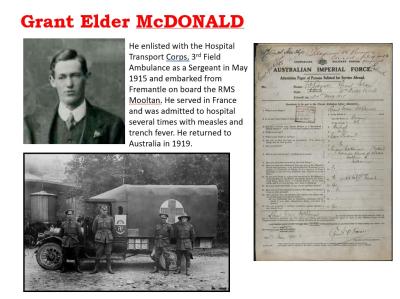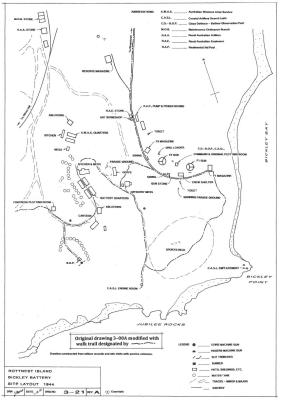World war 1, South-West Asia, Turkiye, Gallipoli, Anzac Cove,421 FARMER, 28 Battalion, 1915
Photograph of 421 Private Lewis Farmer, 28 Battalion
Lewis Farmer was born in Katanning, Western Australia in February 1896. He was the fourth son of William Pegg Farmer and Emily Coyne who were of Aboriginal descent. Lewis’s father William was a highly respected land guide in the Katanning area, whose mother was linked to the Beverley district; whilst his mother’s family came from the Bremer Bay area
On 28 December 1914, Lewis enlisted in the Australian Imperial Force (AIF) at Katanning. He joined the 28th Battalion at Blackboy Hill in March the following year, and trained with the 11th Company Australian Garrison Artillery at Arthur’s Head in Fremantle. On 9 June Lewis embarked at Fremantle on the HMAT Ascanius A11 for Egypt along with his older brother Larry, Randell Mason and Charles Hutchins,
Following another period of training, the Battalion journeyed to Gallipoli on 4 September 1915. Over the next three months, sickness including typhoid, jaundice, pneumonia and rheumatisms accounted for more than one-third of the Battalion’s casualties. After the evacuation of Gallipoli in December 1915, the 28th Battalion proceeded to the Greek island of Lemnos and then back to Alexandria.He was hospitalised twice before departing from Alexandria for on 16 March 1916.
At Pozieres in early August he received a gunshot wound to the leg and was ‘evacuated sick’ to Wandsworth Military Hospital in London for treatment. Lewis returned to France and re-joined his Battalion on 18 December, only to be re-admitted to hospital one month later with trench feet. He was evacuated to the War Hospital in Reading, England, where he remained for almost three months. While in hospital Lewis was recommended for the Distinguished Combat Medal for ‘good work in France.’
In October he returned to the 28th Battalion in France but on 6 April 1918 Lewis was again hospitalised with influenza. After a period of convalescence, Lewis returned to serve at the front through to 19 October when he took two weeks leave in England. He then returned to France where he remained until 20 January 1919, when he returned to England. Lewis embarked for Australia on the HMAT Anchises A68 on 28 February 1919 and berthed in Albany on 7 April. The troopship brought home the largest single contingent of returning soldiers to Western Australia.
On 10 June 1919 he was discharged from the AIF. Lewis remained in the district where over the next fifteen years. Like many Aboriginal ser vicem en wh o fought during World War I, Lewis encountered great difficulty in attaining equal rights, including access to th e local Returned and Ser vices Leagu e (R SL) club. In September 1938 Lewis was issued with an Exemption Certificate. By mid-1939 Lewis was living with his mother in Katanning where he received an invalid pension. On 23 August 1946, Lewis Farmer, aged 50 years, passed away at the Katanning District Hospital. He was buried with full military honours at the Katanning cemetery with the RSL executives and ex-servicemen from both World Wars in attendance.
Details
Details
The service of 13 Diggers, now identified as Aboriginal, original ANZACs, who served with the Australian Imperial Force in Gallipoli are commemorated by name in dioramas in the World war 1 Gallery at the Australian Army Museum of Western Australia.
Australian Army Museum of Western Australia
Australian Army Museum of Western Australia
Other items from Australian Army Museum of Western Australia
- World War 1, South-West Asia, Turkiye, Gallipoli, Anzac Cove. 307 HUTCHINS. 28 Battalion, 1915
- World War 1, South-West Asia, Turkiye, Gallipoli, Anzac Cove, 1952 JACKSON, 28 Battalion, 1915
- World War 1, South-West Asia, Turkiye, Gallipoli, Anzac Cove,1123 LOCKYER, 1915
- World War 1, South-West Asia, Turkiye, Gallipoli, Anzac Cove, 897 MASON, 28 Battalion, 1915
- Medal - Queen Elizabeth II Golden Jubilee Medal
- World War 1, South-West Asia, Turkiye, Gallipoli, Anzac Cove, 2515 MELBOURNE, 5 Battalion, 1915
- World War 1, South-West Asia, Turkiye, Gallipoli, Anzac Cove, 1310 NALEY, 16 Battalion, 1915
- Medal - Meritorious Service Medal (1916-1918) Gallantry and Immediate
- World War 1, South-West Asia, Turkiye, Gallipoli, Anzac Cove, 2413 SHAW, 52 Battalion, 1915
- World War 1, South-West Asia, Turkiye, Gallipoli, Anzac Cove,165 McCALLUM, 16 Battalion, 1915
- World War 1, Western Australia, Perth heritage week Exhibit, 251 McDONALD GE, Hospital Transport Corps
- World War 2, Western Australia, Rottnest Island, Bickley Battery and Bickley Camp, Layout, 1944















